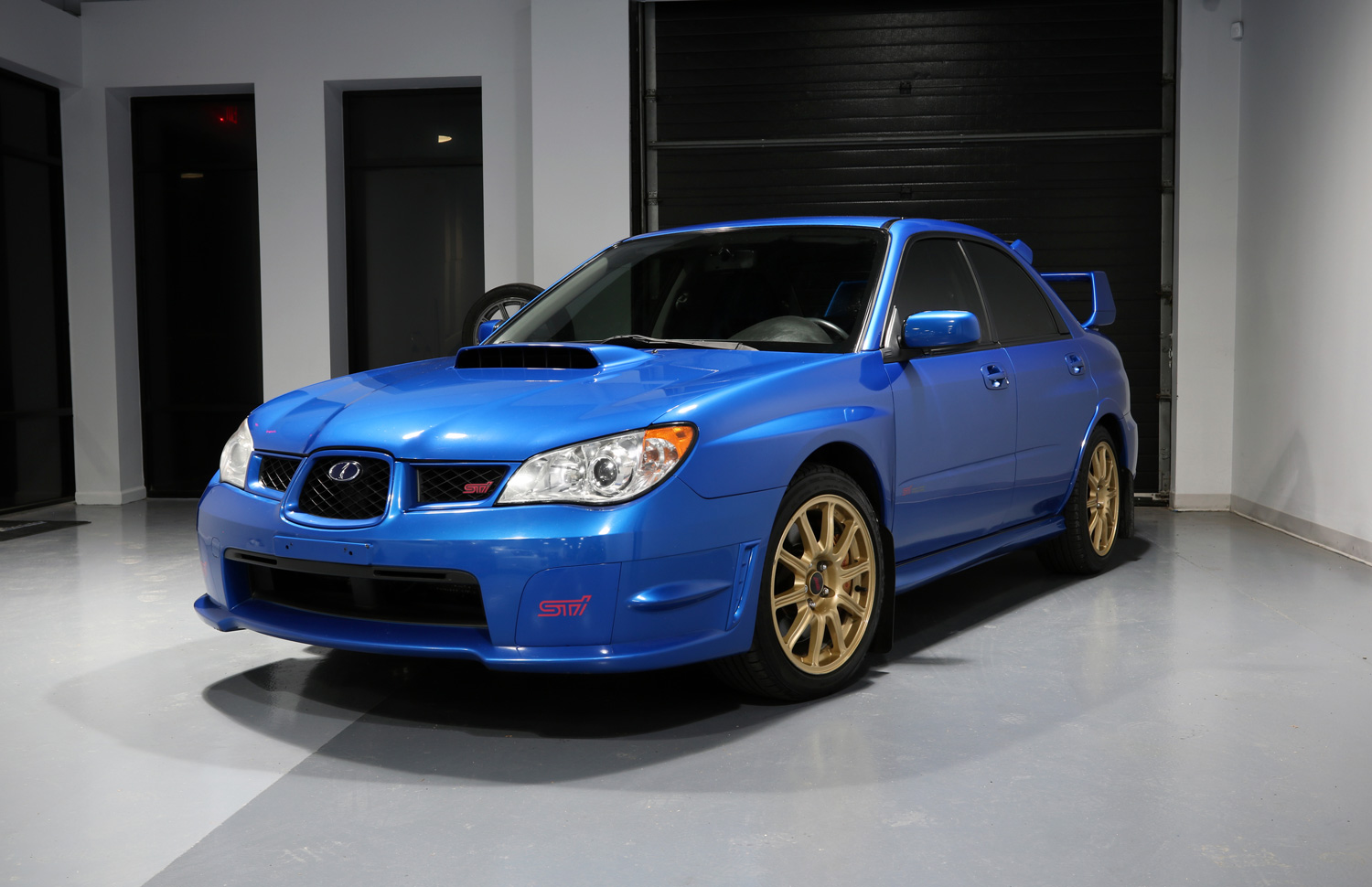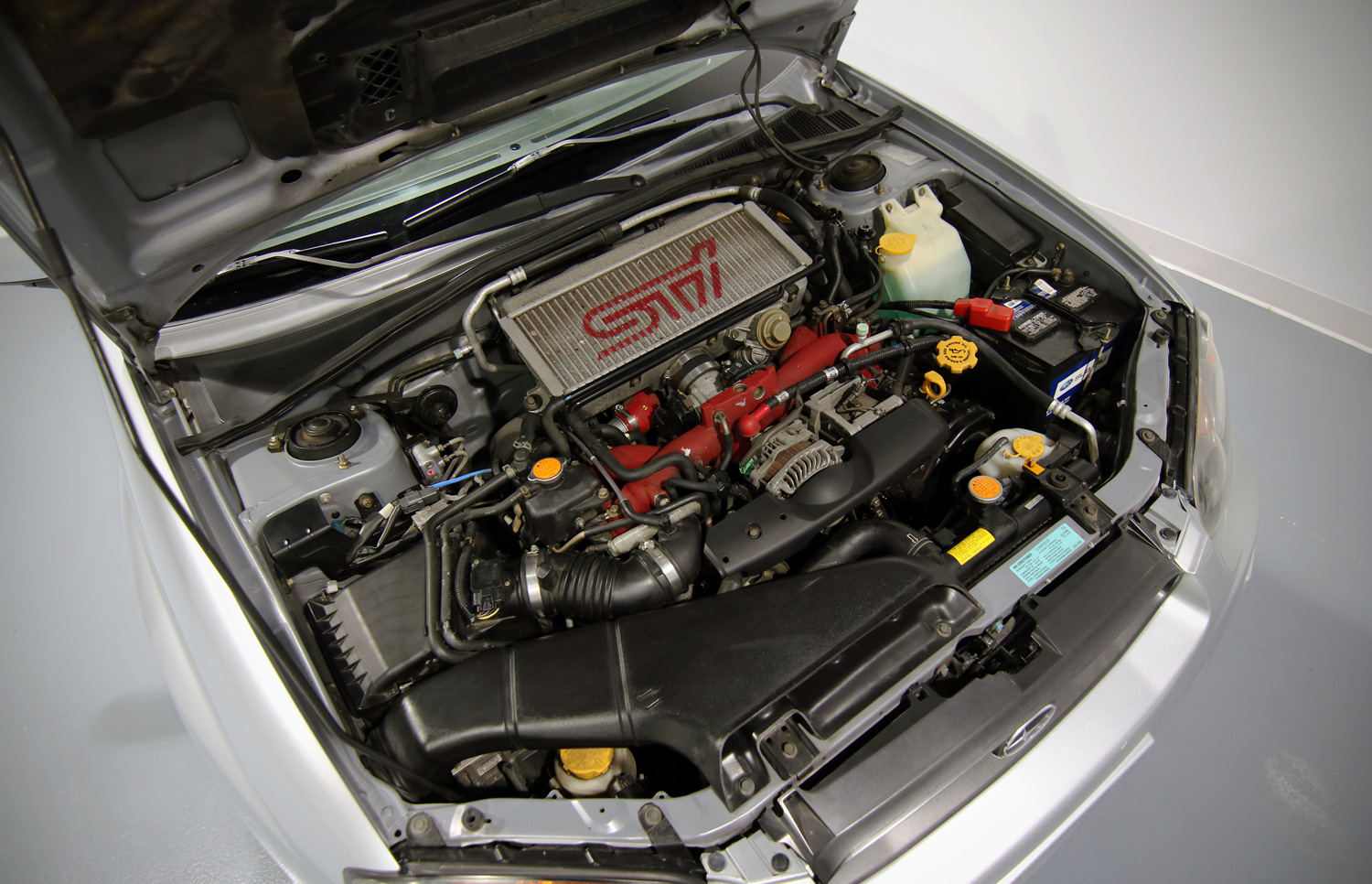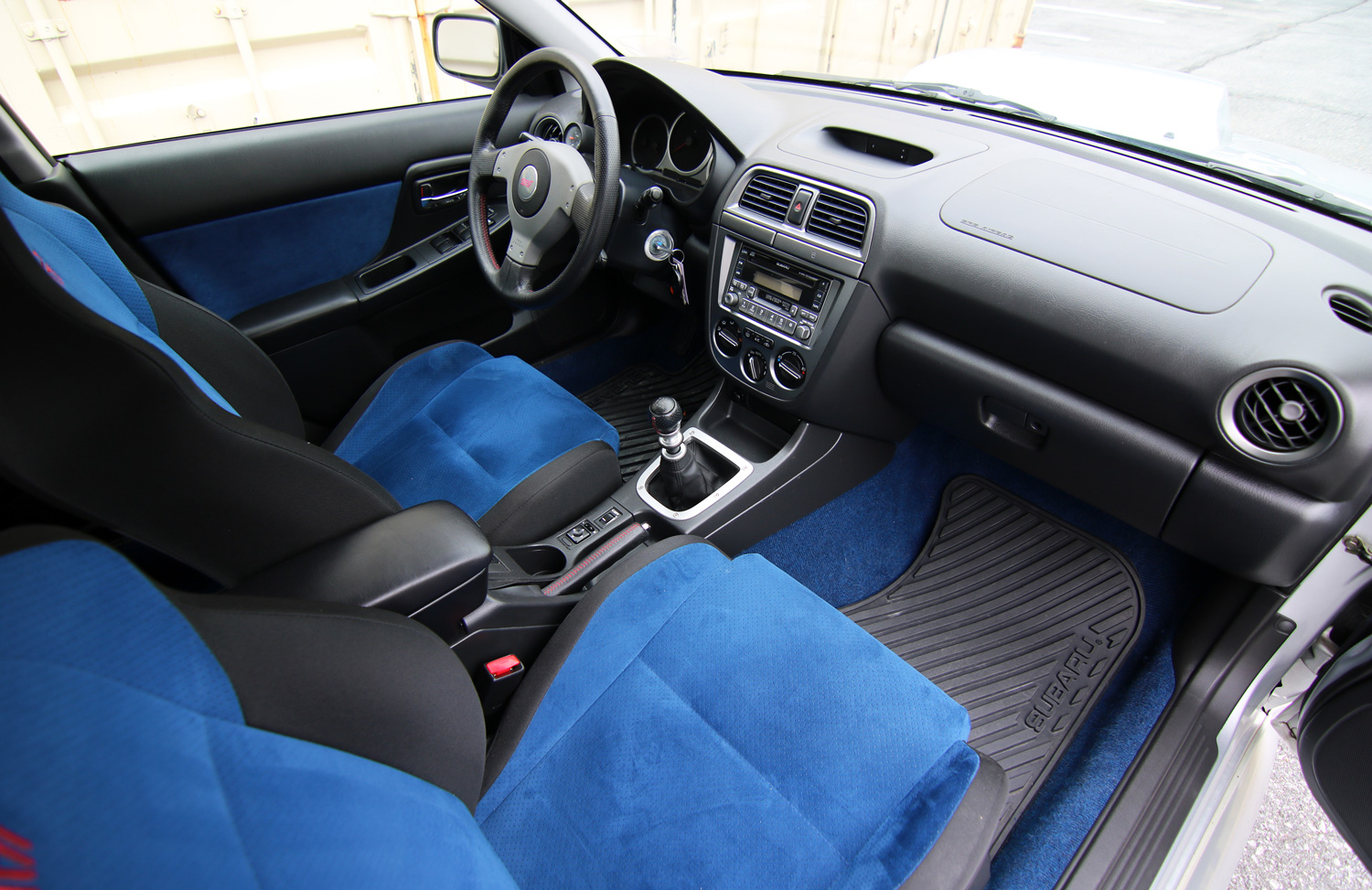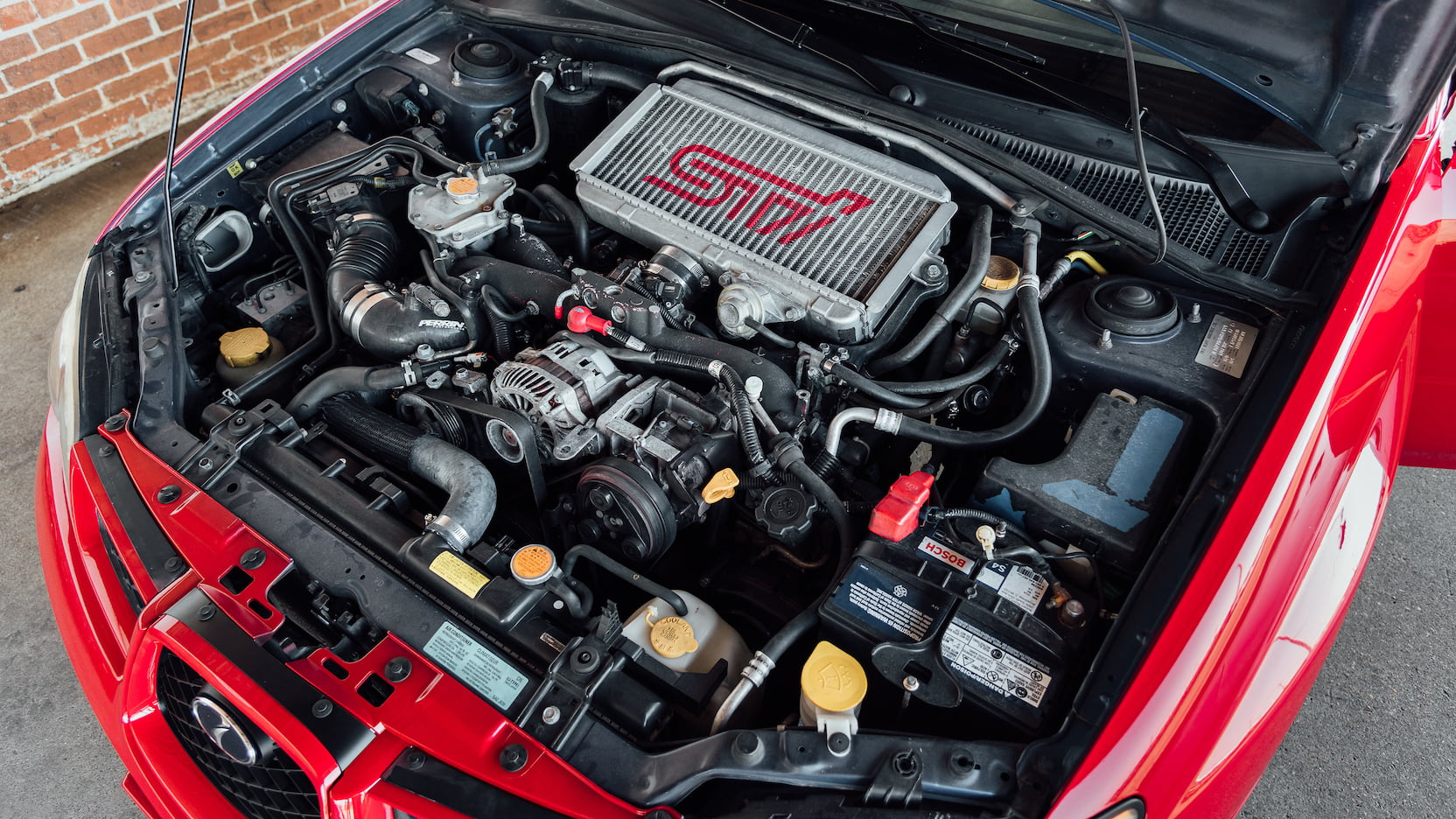Media | Articles
Before you buy a 2004–07 Subaru WRX STI, here’s what you need to know
Subaru’s all-wheel drive, big-winged WRX STI is red hot in the collector car market. Over the last four years, values are up 30-40 percent for the very best examples and about 25 percent for cars that have been used but cared for.
Still, until now Subaru of America refused to tell anyone how many WRX STI Imprezas it sold from 2004–07. The sales volume of Subaru’s hottest performance model from has been a big mystery for more than a decade.
Well, we have the numbers. And we have them broken down by year and color.
Subaru sold a total of 25,813 STIs in the United States from 2004–07. Here’s how they break down, and a detailed buyer’s guide for those in the market.
2004: 7405 total
Marketplace
Buy and sell classics with confidence

World Rally Blue Pearl (Gold Wheels): 1820
World Rally Blue Pearl (Silver Wheels): 1322
Java Black Pearl (Gold Wheels): 679
Java Black Pearl (Silver Wheels): 935
Platinum Silver Metallic (Gold Wheels): 118
Platinum Silver Metallic (Silver Wheels): 1759
Aspen White (Gold Wheels): 301
Aspen White (Silver Wheels): 471
2005: 7747 total

World Rally Blue Pearl (Gold Wheels): 1336
World Rally Blue Pearl (Silver Wheels): 754
Obsidian Black Pearl (Gold Wheels): 718
Obsidian Black Pearl (Silver Wheels): 1029
Platinum Silver Metallic (Gold Wheels): 114
Platinum Silver Metallic (Silver Wheels): 1103
Crystal Gray Metallic (Gold Wheels): 209
Crystal Gray Metallic (Silver Wheels): 1330
Aspen White (Gold Wheels): 549
Aspen White (Silver Wheels): 605
2006: 6083 total

World Rally Blue Pearl (Gold Wheels): 1072
World Rally Blue Pearl (Silver Wheels): 502
Obsidian Black Pearl (Gold Wheels): 625
Obsidian Black Pearl (Silver Wheels): 942
Crystal Gray Metallic (Gold Wheels): 94
Crystal Gray Metallic (Silver Wheels): 736
Steel Gray Metallic (Gold Wheels): 95
Steel Gray Metallic (Silver Wheels): 835
Aspen White (Gold Wheels): 537
Aspen White (Silver Wheels): 645
2007: 4,578 total

World Rally Blue Pearl (Gold Wheels): 800
Obsidian Black Pearl (Silver Wheels): 1158
Crystal Gray Metallic (Silver Wheels): 382
Steel Gray Metallic (Gold Wheels): 95
Urban Gray Metallic (Silver Wheels): 1269 (includes 400 STI Limited)
Satin White Pearl (Gold Wheels): 169
Satin White Pearl (STI Limited with Silver Wheels): 400
2004–07: 25,813 total

World Rally Blue Pearl (Gold Wheels): 5028
World Rally Blue Pearl (Silver Wheels): 2578
Obsidian Black Pearl (Gold Wheels): 1343
Obsidian Black Pearl (Silver Wheels): 3129
Java Black Pearl (Gold Wheels): 679
Java Black Pearl (Silver Wheels): 935
Platinum Silver Metallic (Gold Wheels): 232
Platinum Silver Metallic (Silver Wheels): 2862
Crystal Gray Metallic (Gold Wheels): 303
Crystal Gray Metallic (Silver Wheels): 2448
Steel Gray Metallic (Gold Wheels): 95
Steel Gray Metallic (Silver Wheels): 835
Urban Gray Metallic (Silver Wheels): 1269 (includes 400 STI Limiteds)
Aspen White (Gold Wheels): 1389
Aspen White (Silver Wheels): 1721
Satin White Pearl (Gold Wheels): 169
Satin White Pearl (STI Limited with Silver Wheels): 400
Trending up

Alex Witkin has bought and sold about three dozen STIs since he opened his dealership Performance Auto Gallery in Gaithersburg, Maryland. “We deal in anything that’s fast, fun or interesting,” he says. “But I’ve always been a Subaru guy and I own a modified 2002 WRX that’s been on four or five magazine covers.”
The market for older Japanese performance cars is maturing quickly, and the values of these modern classics are expected to continue rising. If you’re in the market for an early STI, now’s the time to buy. Interest is only increasing.
“Most of my STI customers are guys in their mid-30s that had one before, regrets selling it and wants another one,” says Witkin. “Others wanted one in high school and couldn’t afford it. They’re very knowledgeable about the cars.”
2004–07 Subaru WRX STI year-to-year changes

Subaru Tecnica International, the automaker’s motorsports division, was founded in 1988. Today it’s still a small group of 120 enthusiasts responsible for Subaru’s race cars and high-performance STI models.
With a price tag of $31,520, the WRX STI launched in the United States for the 2004 model year, just two years after the WRX had finally reached America. Although the two look similar, the STI is a very different machine, packing a larger 2.5-liter engine, a six-speed manual transmission, limited-slip differential, larger Brembo brakes, bigger BBS wheels and tires, and its unmistakable rear spoiler, which had been battle-tested by World Rally gods Colin McRae, Petter Solberg, and Richard Burns.
Thanks to 14.5 pounds of turbo boost, they were packing 300 hp from Subaru’s flat EJ25 four-banger, and magazine tests of the day clocked them to 60 mph in 4.6 seconds. That’s almost a full second quicker than the EJ20-powered 227-hp WRX at the time.
This was the second generation (or GD generation) of the Impreza sedan, which launched in 2000, and Subaru didn’t make many changes to the STI during its four-year run. But there are a few key differences buyers should know about.



In 2004, the STI used the same 5×100 hub bolt pattern as the WRX, but in 2005, it changed to 5×114.3 and the STI’s BBS wheels were widened by half an inch. In 2006, the torque split of the all-wheel-drive system was also modified to send more power to the front. The original split was 35/65 but it changed to 41/59.
In 2007, the six-speed got slightly taller second-, third-, and fourth-gear ratios. Changes to the engine were very minor over the years, but they include tweaks to the wastegate actuator and ECU in 2007, and a later reflash fixed some hesitation issues.
Most of the changes were visual. In 2004, the STI wore clear headlamps and red taillights, but Subaru switched to a slightly darker smoked reflector for the headlamps in 2005. Big changes came in 2006, however, when Subaru ditched the “blobeye” design for the “hawkeye” design. Again the lights were tinted, but in 2007 Subaru went back to the clear lamps front and back.
In 2005, Subaru added small plastic body color flares to the rear wheel wells, and a year later the STI wore roof vane spoilers, which its designers cribbed from its rival, the Mitsubishi Evo. Later cars also got a small black diffuser under the rear bumper.

The door decals were tweaked, as well. The STI logo and Subaru Tecnica International text were on the same line the first year, but from 2005–07 Subaru Technica was stacked on top of the word International. If the car is wearing the wrong stickers, it may be a sign it has had some bodywork, but not always.
The STI Limited model was added for 2007, but just 800 were built, 400 in white and 400 in gray. These are the only STIs with leather upholstery. They also got heated front seats, a sunroof, black instead of gold brake calipers, and a slightly different wheel design. Gold wheels were not offered and Subaru replaced the STI’s signature oversized spoiler with a small lip.
“These are really hard to find that haven’t been thrashed,” says Witkin.
The driver’s seats changed slightly over the years, and the door panels got more armrest padding and more Alcantara in 2005. The heating and air conditioning controls and center stack were also modified that year.
Watch out for rust

Given their all-wheel-drive systems and rally reputation, many STIs were driven year round, and their rear fender well arches are notorious for rust. Feel around under there and look for repairs. Also look for rust on the undercarriage, even if the body looks good, and check for rusty bolts on the front radiator supports. If the bolts are fresh on a high mileage car, they were probably corroded.
Another telltale sign of a salty winter car is corrosion on the front seat brackets. The bolts will rust and the black paint on the bracket will flake off over time. “I’ve never seen one rust through the floor,” Witkin explains.
The bumper beams can also corrode. Check. Again, even if the paint looks fresh. Also look at the rear differential housing and trailing arms. They rust.
STIs are known to have a rear strut clunk when the rear suspension flexes over steep driveways. Don’t let the binding noise scare you off; they all do it and it’s not something to worry about.
Other things to check on a 2004–07 Subaru WRX STI

Subaru says the EJ25’s timing belt and water pump should be serviced after seven years or 105,000 miles, whichever comes first. Ask to see a record of this service. If it hasn’t been done, budget for it. It costs about $2000 at a dealership and about $1200 at a reputable independent shop that knows Subarus.
Also of concern is the cost of a new transmission. Although the STI’s six-speed is robust, and they’ve been known to handle 800 hp, the fifth and sixth synchros can be a problem. Listen for a grind during your test drive.
This is a big issue, because STI six-speeds are hot items for guys with WRXs looking to upgrade from that model’s fragile five-speed. This has driven up the price and a replacement six-speed can cost between $3000 and $4000. The prices of STI seats, LSDs, and brakes are also rising for the same reason.
Before you buy any Subaru, get on NASIOC, the forums for the North American Subaru Impreza Owners Club, and take advantage of the community. “It’s a good group of people,” says Witkin. “And at this point, on average, the enthusiast community knows the cars better than the dealers.”
Other good sources of information are websites like MotoiQ and old magazines like Sport Compact Car. Both built up project STIs and have done a ton of editorial on these cars.
Stock STIs will cost you

Many of these cars were modified when new, and they’re still very popular with the aftermarket. Parts are out there to “improve” the STI’s suspension, engine, interior, and body.
The most common upgrades are lowered coilover suspensions, larger wheels and tires, cold air intakes, seats, and front mount intercoolers to replace Subaru’s top mount unit. While we wouldn’t be adverse to a clean example with a few mild modifications, it’s the stock, unmolested examples that are bringing the most money and have the greatest investment potential.
Over the four years GD-chassis STIs were offered in blue (with gold wheels), white, black, and silver. According to Witkin, the white and blue cars tend to sell for more than black and silver examples, and the white cars are very popular right now.
Still, he thinks a blue STI with gold wheels, which was Subaru’s racing colors in the WRC, will prove to be the most popular down the road. Blue Imprezas won the World Rally Championship in 2001 and 2003. “Ultimately, [World Rally Blue] on gold will be the one to have,” he says. “It’s like Ferraris. When people enter the market, they start with a car painted Rosso Corsa with Cuoio leather.”
Current WRX STI values

When buying any collector car, it’s always important to do your research and buy the best example you can afford. On average, a stock GD-chassis STI in very good condition with 40,000 to 60,000 miles costs around $25,000. That’s the heart of the market. In general, in-the-know buyers do gravitate toward the 2004 model, which, owing to its lack of creature comforts compared to later years, is considered the most pure and raw version of these vehicles.
Very low mileage cars that are unmolested and still rolling on their original tires can touch $50,000. According to Witkin, decent cars with mild mods and over 100,000 miles are about $15,000.
At the very bottom of the market are the salvage titles and cars with over 200,000 miles. They go for between $8000 and $10,000. “There’s a lot of those,” says Witkin. “Nobody really expected these cars to be so collectible, so a lot of guys beat the snot out of them.”
Values aside, these are thrilling cars to drive and pleasures to own. Being based on a regular car like the Impreza, they’ll easily handle daily-car duties or road trips without issue, and there’s no doubt the STI can compete with far more expensive and exotic cars when your foot goes to the floor and the turbo spools up. So if you love the STI, turn the key and boost it.










